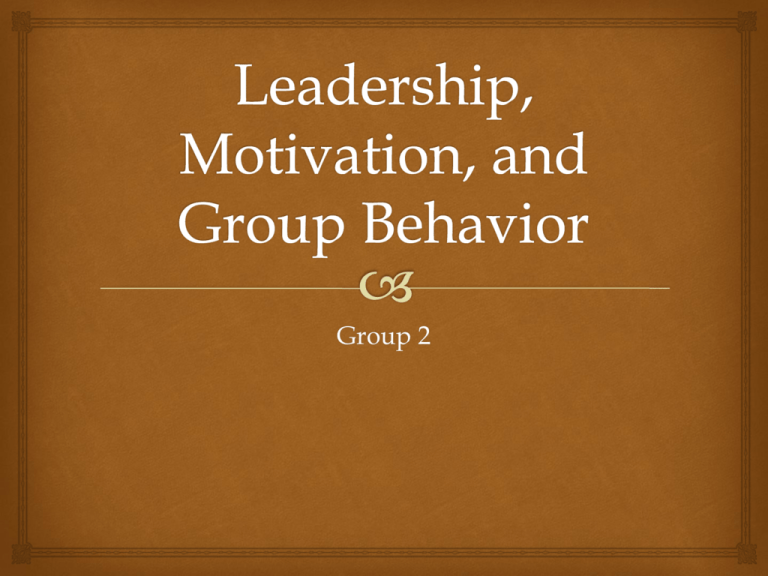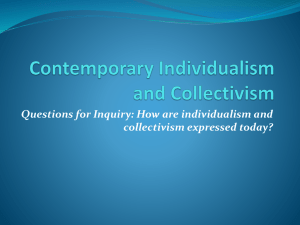Group 2
advertisement

Group 2 Framing leadership: Is the essence of leadership being stuck on the horns of a dilemma? Leadership- Effective if they occupy positions of power Chester Barnard Systems of communication between individuals and groups Motivation Common purpose ‘The Functions of the Executive’ 1968 Thomas Stewart Interview-based research project 1. Revenue growth versus cost containment 2. A short-term versus a long-term focus on plans and results 3. Creativity versus organizational discipline 4. The needs of the people, including adequate time away from work, versus the demands of productivity. 5. specific capabilities of subordinates versus their leadership potential 6. Independence versus dependence of organizational members and departments 7. Bureaucracy busting versus creating economies of scale 8. Trust versus the demand for change 9. Broad-based projects versus only high-visibility projects Cultural View of Leadership Effectiveness Facilitators Universal impediments Culturally contingent endorsement of specifics that work in some cultures but not in others Who is more effective, the instrumental-visionarytransformational leader or headman? Western style One leader, one vision, one strategy Followers implement Ex: Jack Welch, CEO of GE Company valuation increase 400x during tenure Market-pricing model Headman Leadership Two way psychological relationship between leader/follower Beyond work, to cultural and community Leaders have big rewards, but big responsibilities Japanese companies 1000 suicides annually by executives Move from authority ranking to market-pricing model Examples GM Instrumental-visionary-transformational Toyota Headman Nissan Mix When should a leader allow subordinates to participate in decision making? Participation will increase the probability of acceptance of leaders program Low power distance=commitment to organization and participation High power distance=subordinates expect their jobs be dictated to them Leader should consider degree of power distance in a culture before minimizing/maximizing participation Can leaders who publicly humiliate subordinates be effective? Leadership predictors vs. surface features Collectivist • • Public humiliation viewed positively Exception: macho-collectivist cultures Individualist • • Public humiliation viewed as ineffective Hewlett Packard Cultural universals vs. cultural specifics Brazil • Mix of collectivist and individualist Is the relationship between motivation and ability additive or multiplicative in the prediction of individual success and performance? The Expectancy Theory Collectivist, Authority-Ranking Cultures: Additive tendency to avoid rating and ranking managers and employees Individualistic, Market-Pricing Cultures: Multiplicative expect more from managers and workers in terms of putting forth maximum effort http://youtu.be/KFplP0ZNzjQ Can an individually based need hierarchy exist in a collectivist culture? Do effective executives attribute success to themselves or to others? Attribution theory: “explores the manner in which people integrate the various perceptions and stimuli they experience, after which they make generalizations or attributions about personal responsibilities, happenings, and environmental phenomena.” Paradox Fundamental attribution error Oneself Others, including subordinates, superiors, and peers Environment or situation? Successful Executives Individualistic, market pricing culture Collectivistic, authorityranking culture Self-serving bias Tendency to attribute success to ones own effort De-emphasize the efforts of others and environment Relationship between ability and motivation, and effort is multiplicities Ex. America Attribute success largely to work of others Peers, mentors, subordinates Ex. Brazil Failed Executives Individualistic, marketpricing culture Self-serving tendency Blame the environment or situation Blame others Failure had nothing to do with me attitude Collectivistic, authorityranking culture Accept the responsibility and blame Argue that neither others or the environment is a caustic factor Even when they very well could of been Example Study between America and Korea found self-serving bias only in America Ex. Daewoo motor company facing bankruptcy Founder fled the country with most of company funds, mainly responsible, in Korean jail now Chairman laid off 7,000 workers, took responsibility Asked each politician to buy a Daewoo Wrote personal letters to his counterparts at 26,000 companies, begging them to hire at least 1 of his laid of employees Seen bowing to a laid off employee apologizing profusely Do all groups contain free riders, or are all members equally responsible contributors? The free rider effect is where there is no way to assign individual responsibility because one or more members will not do equal work so other member will pick up the slack This free rider effect is greater in as the groups get larger. Individualistic vs. Collectivist When culture is introduced-individualistic, marketpricing cultures reverses the free rider effect. Collectivistic, authority-ranking cultures, work harder in groups than they do alone In General and small groups, do the personalities of individuals primarily reflect the influence of culture? Individualist vs. collectivist Collectivist- emphasize group oriented items: being a member of a family, church, or social group Individualist-stress person centered items: personally responsible, achievement oriented Individualist will adapt to collectivist norms while collectivist will accept Western culture assumes a norm of consistency rather than being shaped by the organization Examples America Brazil Individual Personality Group Personality Individualistic Collectivistic Individualism Less Cooperative Less Cooperative Follows Individualistic Norms Collectivism More Cooperative Strives Harder to Fit-In Works Hard Great Cooperation Should multicultural small groups be managed differently from single-culture groups? Single-culture groups-emphasis is on similarities of group members, norms are established quickly Multicultural groups-3 phase process to enhance efficiency of group 1. Learning how to learn together 2. Discovering group members unique cultural contributions 3. Exploring group polarities What about you? Think of a country you would like to work in, do business in or visit. Is the culture individualistic or collectivist? Is the power distance high or low? Is uncertainty avoidance high or low? Is the country masculine or feminine in its orientation? Is the time orientation short-term or long-term? ORGB2 2010-1011 Edition Nelson/Quick: Cengage Learning Brazil Results: Is the culture individualistic or collectivist? Collectivist Is the power distance high or low? 69-high Is uncertainty avoidance high or low? 76-high Is the country masculine or feminine in its orientation? middle Is the time orientation short-term or long-term? 65-long-term









